The Complete Guide to Language Learning at Home
Feb 9, 2022 Language is a communication skill that develops naturally over time. But that doesn’t mean your child couldn’t use some extra help to begin saying their first words! Speech and language development begins at home with your help. Why not use language activities for toddlers to encourage your child’s speech development even further?
In This Article
- How Does Language Develop?
- Using Everyday Routines for Language Development
- How Does Play Develop?
- Playtime Language Activities for Preschoolers
- Language Activities for Toddlers
- Animal Sound Language Activities
- Play-Doh Activities
- Language Games With Balloons
- Teddy Bear Language Activities for Toddlers
- More Language Development Games Your Toddler Will Love
How Does Language Develop?
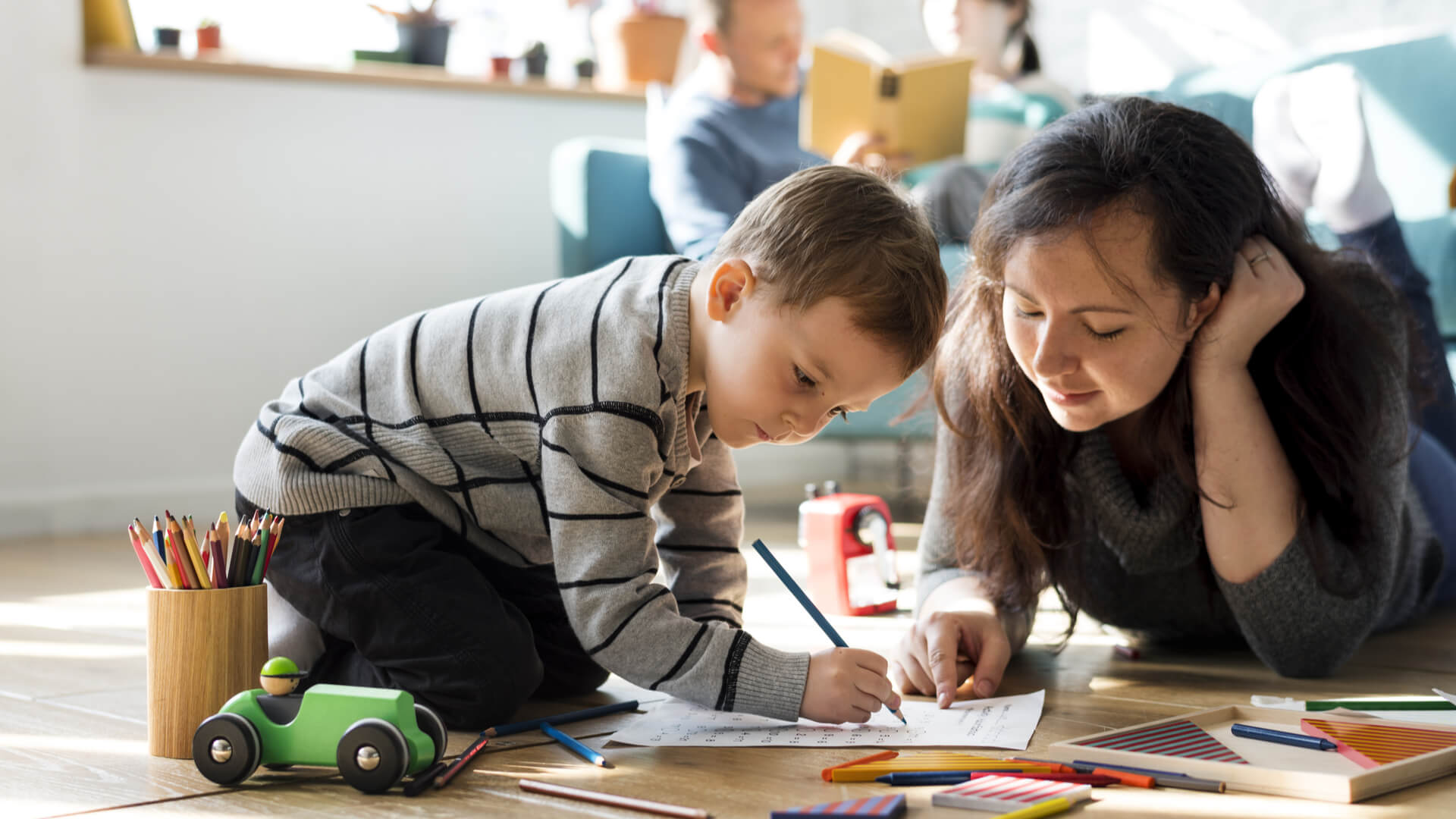
Before exploring activities to improve communication skills, we first need to understand how a child’s first words and language skills are developed. Children learn words at first by hearing the word. Then, in time they will begin to see words through reading and quickly begin to understand the meaning behind different words.
However, the most important way for children to learn first words is hearing the word, over and over. The more you say a word, the more your child understands how to . . .
- Enunciate the word,
- Use the word correctly,
- Understand the concept of the word.
When children first begin to speak they formulate words with familiar sounds they hear each day. First words are then reinforced into memory through seeing those words when they read and see pictures that represent the word. After seeing the actual word with the word object, they then begin to understand the meaning behind the word. For example, an “elephant” is no longer just a word, but a child will understand what an “elephant” looks like, sounds like, where it lives, and more.
To help your child learn his or her first words read the article Wonderful Words – Word Learning for Children!
Recommended article
Using Everyday Routines for Language Development

When it comes to learning speech and language, everything around your child can be used. This includes your child’s daily routine. Here are three functional language activities for boosting speech development!
Making a Fruit Salad with Your Toddler
To incorporate language concepts into the basic task of making a fruit salad, try the following in the routine:
- Name everything you do in making a fruit salad.
- Introduce the idea of categories (different colored fruits, utensils, etc.).
- Ask questions about making the fruit salad (“What are we doing with the fruit”).
- Get them to follow simple directions (“Pass me the banana, please.”).
- Try using back-and-forth communication (“What do we need to do next?”).
- Use complete sentences to describe what you are doing (“I am making a fruit salad.”).
- Repeat those same sentences.
- Include teaching social skills and reasoning (“Do kids play with knives? Why?”) Tell each other stories.
- Recap the activity (“Did we cut up bananas or apples first?”)
For a more in-depth look at this language activity read the article Household Activities as Speech Therapy: Fruit Salad
Recommended article
Household Activities as Speech Therapy: Fruit Salad
Mealtime Language Skills
Try some of the following tips to increase speech for your child’s mealtime routine.
- Offer one bite at a time: This gets your child to ask for “more” in-between bites.
- Offer mealtime choices: Giving food options is an opportunity for your child to communicate non-verbally (pointing) or to say what he or she wants.
- Name the food: Introduce first words for food options like bananas, chicken, and more.
- Introduce adjectives: Say words like hot, cold, and crunchy to describe food items.
- Set the table: Teaching how to set the table helps him/her learn new words and follow simple directions.
This same concept and tips can be applied to other daily routines like bathtime as well!
For more amazing language activities for toddlers read the articles, 10 Ways To Support Language During Your Family Meals and Turn Household Activities Into Speech Therapy: Bath time
Recommended article
Turn Household Activities into Speech Therapy: Bathtime
How Does Play Develop?
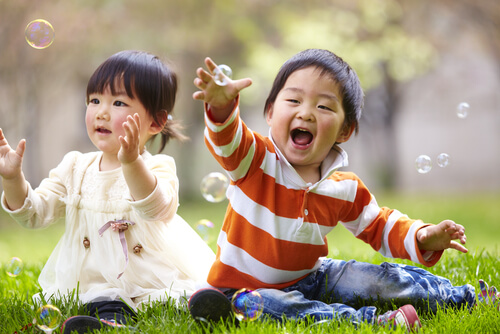
Play skills develop through six stages. Each stage of play development includes key skills that crossover with other stages. But remember, every child develops at their own rate. Also, some stages crossover and build upon themselves, and each child moves through them differently.
The Stages of Play
- Stage 1 – Unoccupied Play: This stage takes place from birth to three-months-of-age. While a baby may not be able to play much, movements of their extremities and facial gestures are all forms of play.
- Stage 2 – Solitary Play: Stage 2 occurs between three months and two-years-of-age. This stage consists of independent play and is typically the longest of the six developmental stages.
- Stage 3 – Onlooker Play: This stage occurs during a child’s second year and consists of a child observing other children playing. It is typically reached with kids who are shy or hesitant to join others during playtime.
- Stage 4 – Parallel Play: Stage four occurs at two-years-old and above. A child in this stage will play alongside other children, but will still play independently.
- Stage 5 – Associative Play: While stages three and four tend to crossover at age two depending on a child’s personality, stage five presents itself between age three and four-years-old. At this stage, a child understands the concept of sharing, playing, and asking questions to other children.
- Stage 6 – Social Play: From four years and up kids will participate in “adult-like socialization.” They play with established rules for games and fantasy-based play will include ‘roles.’ Kids will also learn how to cooperate and solve a problem for a common goal.
Read more about the stages of childhood play development.
Recommended article
6 Stages of Play in Kids (and Play Ideas for Each Stage)
Playtime Language Activities for Preschoolers
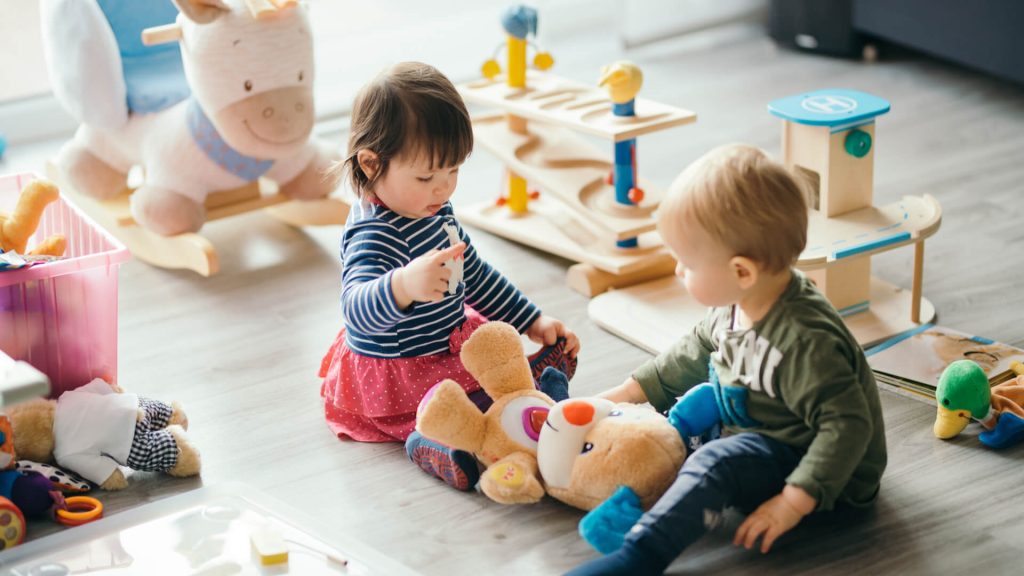
What do the six stages of play development have to do with speech? Children learn best through interaction. The more children interact and are exposed to more speech, language development will flourish! While daily routines provide opportunities for increase speech therapy at home, intentional play provides additional opportunities for boosting first words and communication skills for toddlers skills.
Language Tips and Activities
Birth to 2-years-old
- Imitate facial expressions
- Make animal sounds
- Identify colors
- Use gestures
- Read
- Explore toys like musical instruments
- Have your child engage in sensory play with water or sand
2 to 4-years-old
- Model clear speech
- Repeat what your child says
- Use baby talk mixed with adult words to clarify (“Time for din-din! We’ll eat dinner now”)
- Ask questions
- Make a scrapbook from magazine clippings and organize pictures into easily recognized categories
For more activity ideas, read the article 34 Language Activities To improve Speech For Babies And Toddlers.
Recommended article
Language Activities to Improve Speech for Babies and Toddlers
Language Activities for Toddlers
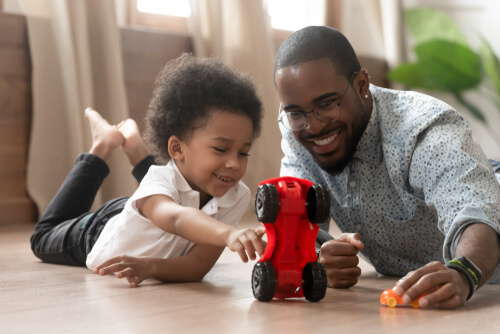
There is an activity for every child no matter what stage of development they are in. If you have a baby under one, here are some easy ways to help develop their first words!
- Animal Jam: Introduce your baby to early animal sounds by saying, “The cow goes moo,” “The duck goes quack.”
- Talk Back: Whenever your baby is crying, cooing, or squealing, communicate with your baby by smiling, waving, or cooing back.
- Name That Color: Since everything is made of color around us, start fostering early color recognition by saying the colors of whatever your baby touches or looks at.
- Mirror, Mirror: When your baby is doing tummy time, place a mirror on the floor for him or her to visually see the facial expressions he/she is making. This helps your baby see how to formulate facial muscles to make sounds and eventually first words.
- Face-to-Face: While facing your baby, help your child learn parts of their body by pointing and saying, nose, eyes, and more.
- Repeat After Me: Once your baby starts babbling after four-months-of-age (especially with vowel sounds) start repeating the exact baby babble your baby says back to him/her.
For 15 more language activities for children under one, read the article 21 Fun Kids Speech Activities To Encourage Speech Development.
Recommended article
21 Kids Activities to Encourage Speech Development
Another way to increase communication skills for toddlers is by using animal sound activities. Between 6 to 11 months most children will say their first words. They learn by hearing and repeating the sounds to formulate new words and funny animal sounds. As a child becomes a toddler their repetition of sounds only increases making it the perfect time to learn animal sounds from the world around them.
Animal Sound Language Activities
- Matching Games with Animals: Simply use matching cards with animals to match one-by-one. This not only helps a toddler with comprehension and memory retention, but it becomes a speech and language activity when they imitate the sound of each animal card they flip over.
- Visit a Zoo: Take your child for a day trip to the zoo! You can use this little adventure to learn first words along with animal sounds. Not only will they see the real animal that makes the sound, but they may also begin to imitate the animal sounds around them!
- Read a Book: We all know reading is essential for helping children develop speech and language. Reading books with animals allows you to add in animal sounds while reading.
Read this article for more animal sound language activities for toddlers!
Recommended article
Teach Animal Sound Activities for Toddlers
Play-Doh Activities
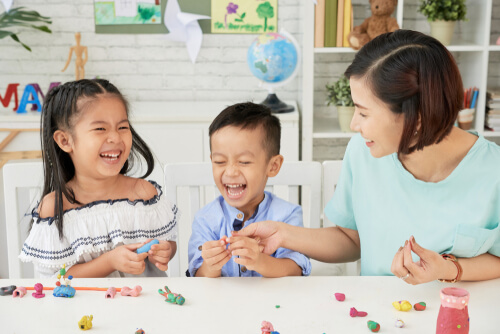
Stamp Letters And Numbers: Use letters and numbers to press into Play-Doh. If your toddler struggles with a certain sound, use that letter to make a word association. (Press a B into the Play-Doh and say “B is for ball.”).
Head, Shoulders, Knees, and Toes: Have your toddler mold Play-Doh into shapes like lips, eyes, and more to teach first words related to parts of the body.
For more Play-Doh language activities for toddlers, read the article Play-Doh Ideas To Encourage Toddlers’ Talking.
Recommended article
Play-Doh Ideas to Encourage Toddlers’ Talking
Language Games With Balloons
Adjective Learning: Use different balloon sizes to show your toddler the difference between “big” and “small.”
Positional Language: Describe what the balloon is doing during a game with small sentences. For example: “Balloon high.”
Get more balloon activities to improve communication skills for toddlers!
Recommended article
25 Language-boosting Toddler Games with a Balloon
Teddy Bear Language Activities for Toddlers
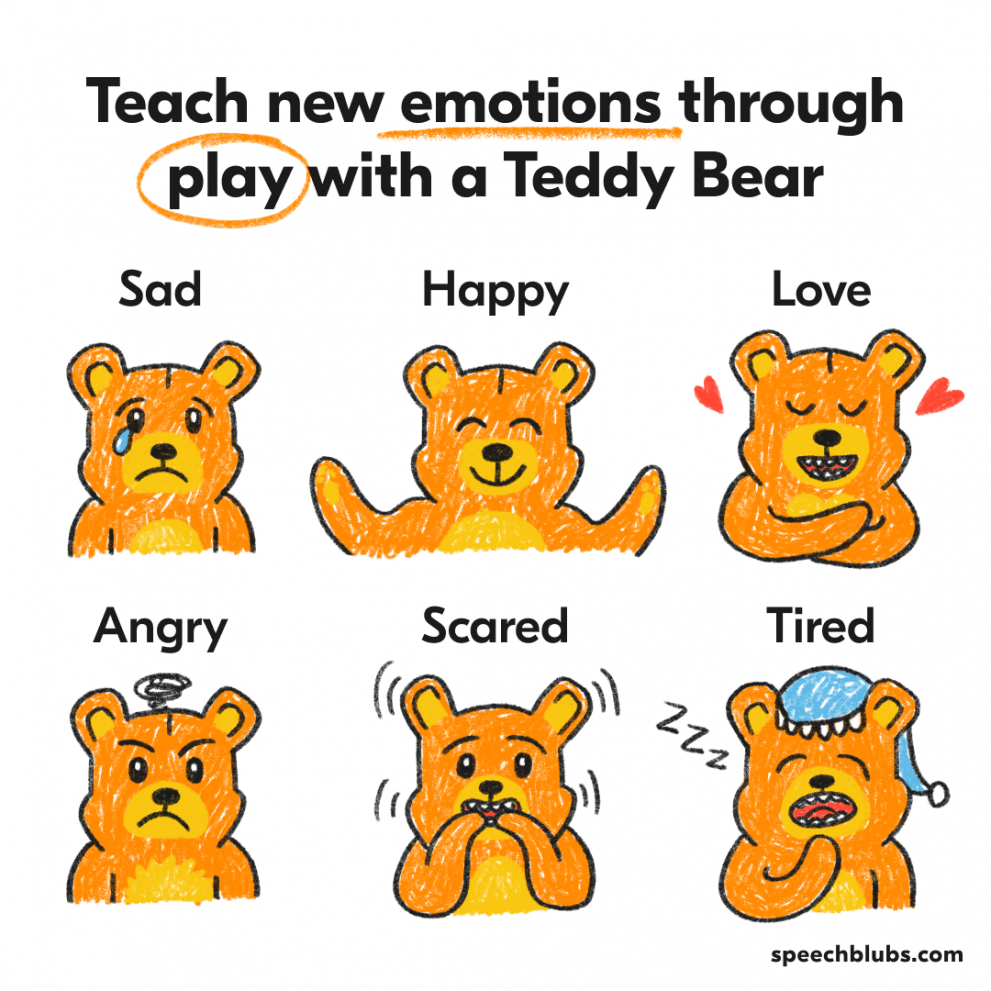
- Emotions: Use a Teddy bear to act out different emotions like happy, excited, and sad.
- Clothes: Layout a selection of your toddlers’ clothes and have your child play dress-up with the teddy bear by following simple instructions on how to dress the bear. This teaches the steps of dressing oneself and the words for clothes.
For more great ideas for speech activities with a teddy bear, read the article 25 Kids Games With A Teddy Bear To Develop Language.
Recommended article
25 Kids Games with a Teddy Bear to Develop Language
More Language Development Games Your Toddler Will Love
- Telephone: Use a plastic toy phone to ask your toddler open-ended questions he/she is likely to answer. For instance, “What would you like for dinner?”
- Supermarket Day: The next time you go grocery shopping with your toddler, name each item you place in the cart and what you intend to use the item for.
Looking for more advanced language activities for children 4- to 5-years-old? Don’t worry Speech Blubs has you covered!
Activities for 4- to 5-year olds
Try some of the following activities with different difficulty levels to increase communication skills for toddlers:
- Creating Creatures: Have your child draw or build a creature out of craft paper or recycled packaging to explore new vocabulary. As your child builds the creature, use adjectives and verbs to describe how the creature looks, moves, or behaves. For toddlers use simple words like feet, tail, walk, sleep, etc. For children over four, use unusual descriptive words like fangs, whiskers, loud, prowl, etc.
- Family Photos: Family photos are a great conversation starter for children. Photos can be used to identify people in the photos by pointing and saying the person’s name. For older children four to five-years-old, make this more difficult by asking questions about what’s happening in the family photos. “What is daddy doing?”
- Treasure Hunt: Write down 5-10 clues on a piece of paper describing what and where the object is in the house. Read the clue one at a time out loud to your child. For example, “yellow, a fruit, monkeys like it” (banana). To make this treasure hunt more complicated simply increase the difficulty of the clues. Example: “I’m hidden behind something rectangular, bright, and turns on with a button” (TV).
- Workout: Use a combination of numbers and exercise instructions to boost speech and comprehension. Try the following examples: Jumping Jacks, Hops, Skips.
For similar ideas like these read the article Staying At Home And Developing Spoken Language.
Recommended article
Staying at Home and Developing Spoken Language
Speech and language are a natural part of childhood development. While every child develops at their own rate, it’s still important to utilize language activities for toddlers to increase communication skills no matter if your child is 6-months-old or 5-years-old. Milestones are just context, but they may help you see if baby or toddler activities are needed to boost your child’s speech development!
